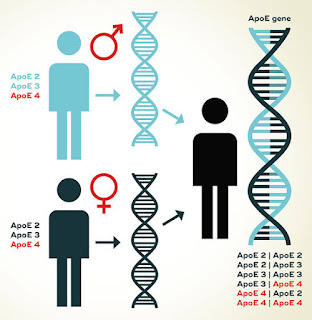In biology, a gene is a sequence of DNA and RNA that codes for a molecule that has a function. During gene expression, the DNA is first copied into RNA. The RNA can be directly functional or be intermediate template for a protein that performs a function.
- What do you mean by "genetics" ? 🤔🤔🤔
Definition:
Genetics is a branch of biology concerned with the study of genes, genetic variations and heredity in living organisms. Gregor Mende, a scientist and Augustinian friar, discovered genetics in late 19th century.
- Introduction to genetics:😮😮😮
Genetics is a field of biology that studies how traits are passed from parents to their offspring. The passing of traits from parents to offspring is known as heredity, therefore, genetics is the study of heredity. This introduction to genetics takes you through the basic components of genetics such as DNA, genes, chromosomes and genetic inheritance.
Genetics is built around molecules called DNA. DNA molecules hold all the genetic information for an organism. It provides cells with the information they need to perform tasks that allow an organism to grow, survive and reproduce. A gene is one particular section of a DNA molecule that tells a cell to perform one specific task.
Heredity is what makes children look like their parents. During reproduction, DNA is replicated and passed from a parent to their offspring. This inheritance of genetic material by offspring influences the appearance and behavior of the offspring. The environment that an organism lives in can also influence how genes are expressed.
- Let us get introduced by the term "human genome" 😀😀😀
The human genome is the complete set of nucleic acid sequence for humans, encoded as DNA within the 23 chromosomes pairs in a cell nucle and in a small DNA molecule found within individual mitochondria. Human genome include both protein-coding DNA genes and noncoding. Haploir human genomes, which are contained in germ cells (the egg and sperm gametecells created in the meiosis phase of sexual reptoduction before fertilization creates a zytote) consist of three billion DNA base pairs , while diploid genomes (found in somatic cells) have twice the DNA content. While there are significant differences among the genomes of human individuals (on the order of 0.1%),these are considerably smaller than the differences between humans and their closest living relatives, the chimpanzees and bonobos.
- M.S. Swaminathan - India in genetics 😯😯😯
Born: 7 August 1925 (age 93 years), Kumbakonam
Mankombu Sambasivan Swaminathan (born 7 August 1925) is an Indian geneticist and international administrator, renowned for his leading role in India's Green Revolution, a program under which high-yield varieties of wheat and rice seedlings were planted in the fields of poor farmers. Swaminathan is known as the "Father of Green Revolution in India" for his leadership and success in introducing and further developing high-yielding varieties of wheat in India. He is the founder of the MS Swaminathan Research Foundation. His stated vision is to rid the world of hunger and poverty. Swaminathan is an advocate of moving India to sustainable development, especially using environmentally sustainable agriculture, yipee sustainable food security and the preservation of biodiversity, which he calls an "evergreen revolution."
- Father of modern genetics: 😎😎😎
Gregor Mendel is known as father of modern genetics.
Mendel worked with seven characteristics of pea plants: plant height, pod shape and color, seed shape and color, and flower position and color. Taking seed color as an example, Mendel showed that when a true-breeding yellow pea and a true-breeding green pea were cross-bred their offspring always produced yellow seeds. However, in the next generation, the green peas reappeared at a ratio of 1 green to 3 yellow. To explain this phenomenon, Mendel coined the terms “recessive” and “dominant” in reference to certain traits. (In the preceding example, the green trait, which seems to have vanished in the first filial generation, is recessive and the yellow is dominant.) He published his work in 1866, demonstrating the actions of invisible “factors”—now called genes—in predictably determining the traits of an organism.
- Genetic Engineering: 🤨🤨🤨
Genetic engineering, also called genetic modification or genetic manipulation, is the direct manipulation of an organism's genes using biotechnology. It is a set of technologies used to change the genetic makeup of cells, including the transfer of genes within and across species boundaries to produce improved or novel organisms . New DNA is obtained by either isolating and copying the genetic material of interest using recombinant methods or by artificially synthesising the DNA. A construct is usually created and used to insert this DNA into the host organism. The first recombinant DNA molecule was made by Paul Berg in 1972 by combining DNA from the monkey virus SV40 with the lambda virus . As well as inserting genes , the process can be used to remove, or "knock out", genes. The new DNA can be inserted randomly,targeter to a specific part of the genome.
- Genetic Diseases: 😓😓😓
A genetic disorder is a genetic problem caused by one or more abnormalities in the genome. Most genetic disorders are quite rare and affect one person in every several thousands or millions.
Genetic disorders may be hereditary , meaning that they are passed down from the parents' genes. In other genetic disorders, defects may be caused by new mutations or changes to the DNA . In such cases, the defect will only be passed down if it occurs in the germline.








